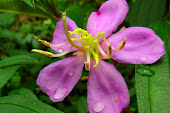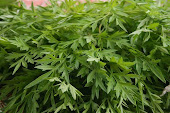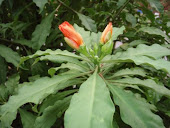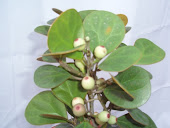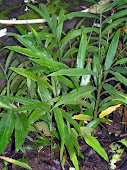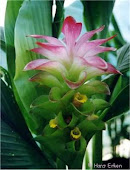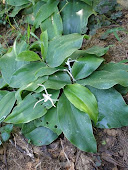
Common Names: Aloe Vera, True Aloe, aloe vera, aloe, burn plant, lily of the desert, elephant's gall.
Latin Names: Aloe vera, Aloe barbadensis
BACKGROUND
Aloe vera is obtained from the mucilaginous tissue which is located at the center of the leaf. Numerous scientific researches have indicated that aloe vera has many benefits and healthy functions to human body. Studies have shown that aloe vera can be used as a tonic for immune system, help fighting kinds of illness.
 Structure of carbohydrate
Structure of carbohydrateIt is mainly composed of carbohydrates and lipids. Carbohydrates in the aloe vera include mono- and polysaccharides, tannins, sterols, organic acids, and saponins whereas the lipids include cholesterols, gamolenic acid, and arachidonic acid. Aloe vera also naturally contains in vitamin C, amino acids, enzymes, germanium, protein, calcium, magnesium, zinc, essential fatty acids, vitamins A, B12, and E. Below are the following benefits of aloe vera according to its contents:
Vitamin C:
- Helps maintain tone of blood vessels
- Promotes smooth blood circulation
- Essential to the adrenal gland
- Support human body during stress
Amino acid:
- Acts as building block of protein in our body
Germanium:
- A mineral that have therapeutic effects:
- Immunodeficiency, pain, cardiac disorders, and eye problems
BENEFITS of ALOE VERA
Thousand years ago, transparent gel of aloe vera leaves has been used to treat many dermatologic conditions (e.g:burns, wounds, skin infections). Traditionally, aloe vera has been used in ointments and creams preparations.

Recently, over 200 worldwide scientific research papers about aloe vera have been published and it has 3 categories of researches which are anti-inflammatory, antibacterial, and antiviral actions of aloe vera.
Aloe vera juice has lots of benefits and is believed to be the finest body cleansers. The juice can soothe digestive tract irritations like colitis, ulcers, and irritable bowel syndrome.
Based on Journal of the American Osteopathic Society, (1963, vol.62), it is good for ulcer-healing effects since it encourages the release of gastric juice enzyme (pepsin) during full stomach.
Oral use of aloe vera also may clean morbid matter from the stomach, liver, kidneys, spleen, bladder, and has been considered as the finest colon cleanser.
Drinking aloe vera juice can reduce the severity of asthma due to its anti-inflammatory effects. Few scientific evidences have proved that dried latex of aloe vera leaves has laxative properties which can treat constipation.

The gel has been reported to be effective in the treatment of mouth ulcers.
Hydrophilic cream and lotion of aloe vera have been suggested as effective treatment of psoriasis vulgaris and seborrheic dermatitis respectively.

Recently, over 200 worldwide scientific research papers about aloe vera have been published and it has 3 categories of researches which are anti-inflammatory, antibacterial, and antiviral actions of aloe vera.
Aloe vera juice has lots of benefits and is believed to be the finest body cleansers. The juice can soothe digestive tract irritations like colitis, ulcers, and irritable bowel syndrome.
Based on Journal of the American Osteopathic Society, (1963, vol.62), it is good for ulcer-healing effects since it encourages the release of gastric juice enzyme (pepsin) during full stomach.
Oral use of aloe vera also may clean morbid matter from the stomach, liver, kidneys, spleen, bladder, and has been considered as the finest colon cleanser.
Drinking aloe vera juice can reduce the severity of asthma due to its anti-inflammatory effects. Few scientific evidences have proved that dried latex of aloe vera leaves has laxative properties which can treat constipation.

The gel has been reported to be effective in the treatment of mouth ulcers.
Hydrophilic cream and lotion of aloe vera have been suggested as effective treatment of psoriasis vulgaris and seborrheic dermatitis respectively.
Reference:
http://nccam.nih.gov/health/aloevera
http://nlm.nih.gov/medlineplus/druginfo/natural/patient-aloe.html
by Norashikin Bt Mohamad Sapuan

Common name: Ginger
Latin Names: Zingiber officinale
Introduction:
Ginger is a tropical plant that has green-purple flowers with aromatic rhizome (underground stem). It is commonly used among people in cooking or even as a medicine. This practices have been that long times before by the old people. They may probably do not know what it actually done, but they are sure they give good effects.
It was cultivated in China and India, and reached the West at least 2000 years back. Most of the Chinese’s traditional medicines’ prescriptions are combination of variety of herbs and ginger is used nearly half of that for mediating the effects of the other ingredients. Besides that, it stimulates the appetite and calm the stomach. Differ with European herbal traditions which use it to stop nausea and quiet upset stomach.

BENEFITS OF GINGER
The benefits of ginger root to health are countless. It has antiseptic, stimulating, digestive, expectorant, aphrodisiac (arousing sexual desire), carminative (relieve flatulence), anti-inflammatory and analgesic properties, that can be used to treat a wide range of ailments and illnesses.
Nausea and vomiting
It has been proven that ginger is generally effective as an emetic (relieves vomiting). Ginger root helps in preventing, relieving and reducing motion sickness and nausea and vomiting related to pregnancy or in other word ‘morning sickness’. Nausea and vomiting due to chemotherapy and seasickness also can be reduced by ginger. However, large doses taken during pregnancy is discourage due to concerns about mutations or abortion. Additional researches are carried to determine the safety of ginger during pregnancy.
Diarrhea
The juice of ginger root is very effective in curing gastrointestinal and digestive ailment such as diarrhea, food poisoning, constipation and indigestion. This effect is attributed by zingerone, a compound in ginger that also contributes to the pungent taste. Its carminative properties help to relieve food poisoning symptoms and also cure bacterial dysentery and intestinal infections.


Pain and Inflammation
Ginger also acts as anti-inflammatory and analgesics. Effectiveness can be seen especially among the osteoarthritis of the hip or knee and rheumatoid arthritis.
The effectiveness may be related to inhibition of prostaglandin and leukotriene biosynthesis. 8-Gingerol, not 6-Gingerol was shown to inhibit COX-2 expression, which is induced during inflammation to amplify formation of prostaglandin.
Menstrual Cramps
Ginger juice when used together with some lemon juice in lukewarm water, is very beneficial in treating painful and irregular menstruation.
Stress
Soothing effect of the ginger give an advantage that helps to relief stress, depression and anxiety.
Preparations:
Fresh root, dried root, capsules, tablets, tinctures, and standardized products. The dried roots have synergistic interaction between compound in essential oil and pungent principles such as gingerol.
Cautions:
1. Ginger capsules should be taken with a full glass of water or fluid.
2. Ginger can be taken the day after surgery to prevent post surgery nausea but should be stopped at least three to four days prior to surgery, due to the fact that it can make blood platelets less sticky and therefore increases the risk of bleeding.
3. Patients with gall bladder disease should avoid it
4. Do not exceed the recommended dose.
References:
http://www.nlm.nih.gov/medlineplus/druginfo/natural/patient-ginger.html
http://www.buzzle.com/articles/health-benefits-of-ginger-root.html
http://www.nutritional-supplements-health-guide.com/benefits-of-ginger.html
http://nccam.nih.gov/health/ginger/
Steven Foster. (1996). Herbs for Your Health: A Handy Guide for Knowing and Using 50 Common Herbs. United States. Interweave Press
Packer L., Choon Nam Ong, Halliwell Barry. (2004)Herbal and Traditional Medicine (Molecular Aspects of Health). United States. Marcel Dekker
by Siti Latifah Azirah Bt Mohd Noor
Labels:
beauty,
benefits,
caution,
diarrhea,
ginger,
herbs,
inflammation,
menstrual cramps,
nausea,
pain,
preparation,
vomitting
|
|


- Family: Mackinlayaceae

To be found in:
- India, Sri Lanka, northern Australia, Indonesia, Iran, Malaysia, Melanesia, New Guinea, and other parts of Asia
Habitat:Grow on wet areas like orchard and plantation and along ditches
Common names:
Gotu Kola, Asiatic Pennywort, Indian Pennywort, Luei Gong Gen, Takip-kohol, Antanan, Pegagan, Pegaga, vallaarai, Kula kud, Bai Bua Bok, Brahmi, rau má(Vietnamese), Manimuni(Assamese), Bemgsag, (Brahma manduki, Brahmanduki,
Brahmi, Ondelaga (North India, West
India), Gotu kola, Khulakhudi,
Mandukparni, Mandookaparni,
Mandukaparni (South India), or
Thankuni depending on region in
India), Tapak Kuda(Indonesia)
Scientific name:
Hydrocotyle asiatica L., Trisanthus cochinchinensis (Lour.)

Description:
• stems : slender
• stolons :creeping
• Color: green to reddish green
• interconnecting one plant to another
• Rootstock: consists of rhizomes, growing vertically down, creamish in color and covered with root hairs.
• Stalk: long, green, reniform leaves with rounded apices which have smooth texture with palmately netted veins
• Leaves: grow on pericladial petioles, around 2 cm
• Flowers : pinkish to red in color, small and rounded bunches (umbels) near the surface of the soil. Each flower is partly enclosed in two green bracts, bears five stamens and two styles, and 5-6 corolla lobes per flower. The hermaphrodite flowers are minute in size (less than 3 mm)
• Fruit: densely reticulate

Medicinal effects:
• mild adaptogen, is mildly antibacterial, anti-viral, anti-inflammatory, anti-ulcerogenic, anxiolytic, a cerebral tonic, a circulatory stimulant, a diuretic, nervine and vulnerary
• A decoction of juice from the leaves is thought to relieve hypertension and also used as a general tonic for good health.
• A poultice of the leaves is used to treat open sores
• eaten as a salad leaf, pegaga is thought to help maintain youthfulness
• ability to aid wound healing usually used traditionally in leprosy
• used to re-vitalize the brain and
nervous system, increase attention
span and concentration
• has anti-oxidant properties

• used in Thailand for opium detoxification
• improve appetites
• to treat swollen and cramp legs
• avoid depression
• help to relief digestion problem
• to treat hemorrhoids
• to make the flow of the menstrual blood becoming smooth for women having menstrual problem
• act as a cure to treat white discharge from the vagina
• Decoction liquid of the leaf of pegaga can decrease the body temperature and good to be practice on patient with fever, asthma and bloody stool.
• Drinking boiling of the root of this
herb is believed to control the blood
glucose level for diabetic patients
• Acts as tonic to cleanse the blood, to
treat ulcer, syphilis and lymph nodes

• Pressing of its leaf with water is good to be apply on wound and scabies
• Have effects in development of tissue such as treat scar, build collagen and stimulate the growth of nails and hairs
• Become as a compulsory dish for women after delivering baby for quickening the healing process of the womb
Shoot of pegaga contain tetripenoid enzyme for the treatment of cancer and also use as a basic ingredient in formulating skin care cosmetic products.
Ayurvedic medicine:
For improving memory

Types of pegaga in Malaysia
1. Pegaga Cina Atau Pegaga Nyonya
2. Pegaga Daun Lebar
3. Pegaga Kelantan
4. Pegaga Renek
5. Pegaga Salad
6. Pegaga Gajah
7. Pegaga Brunei
8. Pegaga salad, like salad’s leaf
9. Pegaga hitam
10. Pegaga, found in village
Negative effect:
It can be eaten in a small quantity since it will give narcotic or toxic effects if taken in a large quantity. Eating with a large amount will give rise to the growth of cancer in the long run.

Appreciation:
(WHO) had appreciated “Pegaga” as the herbs that can improve intelligence especially among children.
References :
http://en.wikipedia.org/wiki/Centella_asiatica
http://www.hear.org/starr/plants/images/species/?q=centella+asiatica
http://pkukmweb.ukm.my/~ahmad/tugasan/s2_99/a64967.htm
http://halaqah.net/v10/index.php?topic=5610.0
http://www.bio-asli.com/herb/daun.asp#pengaga
prepared by,
Noorasyikin binti Osman
Aimi Nabilah binti Hashim





